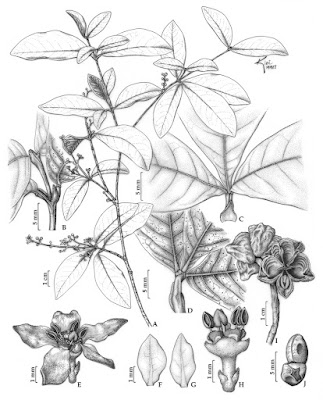[Most Recent Entries] [Calendar View]
Thursday, September 29th, 2022
| Time | Event | ||||
| 2:27a | [Botany • 2022] Sinosenecio yangii (Asteraceae: Senecioneae) • A New Species from Guizhou, China
Abstract A new species Sinosenecio yangii D.G. Zhang & Q. Zhou (Asteraceae, Senecioneae) from Guizhou Province, China, is described and illustrated based on its morphological characteristics and molecular evidence. It closely resembles S. confervifer and S. guangxiensis, the former in the scapigerous habit and smooth and glabrous achene surface, the latter in the calyculate involucre and purple abaxial leaf surface, and both in the shape and indumentum of leaf lamina, but differs markedly from the latter two in having fewer capitula and epappose achenes. Phylogenetic analysis based on nrITS and ndhC-trnV sequences shows that this new species belongs to the S. latouchei clade and is sister to S. guangxiensis with moderate support. Keywords: molecular evidence, morphology, pappus
Sinosenecio yangii D. G. Zhang & Q. Zhou, sp. nov. Morphological observation (Fig. 1) showed that S. yangii, S. confervifer, and S. guangxiensis share obvious resemblance in the leaf blade shallowly undulate and suborbicular, adaxially densely to sparsely villous and abaxially sparsely pubescent or nearly glabrous (Table 2). In addition, S. yangii is similar to S. confervifer in the stem leafless or with 1–2 bract-like leaf and smooth achene surface, and to S. guangxiensis in the calyculate involucre. Nevertheless, S. yangii differs from both species in having fewer capitula (usually 1–3) and epappose achenes. The metaphase chromosomes of this species were counted to be 2n = 48 (Fig. 2A). The achene surface was glabrous and smooth (Fig. 2B) and the anther endothecial cell wall thickenings were polarized and radial (Fig. 2C). Etymology: The species was named after Professor Qin-er Yang, an expert in the field of Asteraceae at the Chinese Academy of Sciences. The Chinese name is given as “亲二蒲儿根” (qīn èr pú ér gēn). Distribution and habitat: Sinosenecio yangii is known from Lihua Town, Libo County, Guizhou Province, China (Fig. 6). It was collected from a rock cliff by the side of a rural road in this town, at an altitude of 347 m. Jing-Yi Peng, Dai-Gui Zhang, Tao Deng, Xian-Han Huang, Jun-Tong Chen, Ying Meng, Yi Wang and Qiang Zhou. 2022. Sinosenecio yangii (Asteraceae), A New Species from Guizhou, China. PhytoKeys. 210: 1-13. DOI: 10.3897/phytokeys.5555.89480 | ||||
| 2:33a | [Botany • 2022] Curcuma suphanensis & C. rosea (Curcuma subg. Ecomata, Zingiberaceae: Zingibereae) • Two New Species from Central and Southwestern Thailand
Abstract Two new species of Curcuma L. are described. The first species, Curcuma suphanensis P. Saensouk, Boonma, Rakarcha, Maknoi, Wongnak & S. Saensouk sp. nov. was found in Suphan Buri province, Central Thailand, and the second species namely C. rosea P. Saensouk, S. Saensouk & Boonma sp. nov. was found in Uthai Thani province, Southwestern Thailand. Both species fall into the subgenus Ecomata because of the lack of conspicuous coma bract, and the presence of epigynous glands. This brings the number of species in this subgenus worldwide to 37 species. Living specimens and spirit specimens of both new species were collected from their natural habitats, morphological attributes measured, and compared to all existing species. Neither species match any previously-described species, therefore, both of them are new species to science. The first was named Curcuma suphanensis based on its province of origin (Suphan Buri Province), and the second species was named Curcuma rosea, on account of its pinkish bracts. Morphological descriptions along with their illustrations, notes on their ecology, etymology, and distributions, are presented along with a revised key to species of Curcuma subgenus Ecomata worldwide to facilitate identification. Keywords: Curcuma eburnea, Curcuma pitukii, Suphan Buri, Uthai Thani, taxonomy, Zingiberales Curcuma suphanensis P. Saensouk, Boonma, Rakarcha, Maknoi, Wongnak & S. Saensouk sp. nov. กระเจียวสุพรรณ Curcuma rosea P. Saensouk, S. Saensouk & Boonma sp. nov. กระเจียวอุทัย Piyaporn Saensouk, Thawatphong Boonma, Sarayut Rakarcha, Charan Maknoi, Mathee Wongnak and Surapon Saensouk. 2022. Two New Species of Curcuma Subgenus Ecomata (Zingiberaceae: Zingibereae), from Central and Southwestern Thailand. Biodiversitas. 23: 4578-4588. https://smujo.id/biodiv/article/view/118 | ||||
| 10:05a | [Botany • 2013] Metrodorea concinna (Rutaceae) • A New Species from Brazil: Morphology, Molecular Phylogenetics, and Distribution
Abstract A new species of Metrodorea (Rutaceae), M. concinna, is described and illustrated, and morphological, molecular phylogenetic, and distributional support for the new taxon and its relationships with morphologically similar species, as well as with sympatric ones, are explored. The new species is endemic to semideciduous forests of southeastern Bahia, eastern Brazil. It is distinct from other species of the genus mainly by the combination of shrubby to treelet habit, (sub)sessile leaves, sessile leaflets without conspicuous, dark glands on the abaxial surface, and by each carpel bearing one dorsal apophysis. In addition to the diagnostic morphological features, molecular data provide further support to the new taxon. Keywords: Rutaceae, new species, Brazil Metrodorea concinna Pirani & P.Dias, sp. nov. Etymology:—The epithet concinna is derived from the Latin term concinnus, which means “pretty,”“neat,” “elegant,” referring to its habit and leaf arrangement. Pedro Dias, Renata Giassi Udulutsch and José Rubens Pirani. 2013. A New Species of Metrodorea (Rutaceae) from Brazil: Morphology, Molecular Phylogenetics, and Distribution. Phytotaxa. 117(2); 35-41. DOI: 10.11646/phytotaxa.117.2.1 |
| << Previous Day |
2022/09/29 [Calendar] |
Next Day >> |














